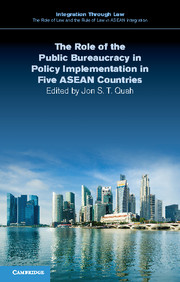
The Role of the Public Bureaucracy in Policy Implementation in Five ASEAN Countries
This pioneering book addresses an important gap in the literature by comparing the role of the public bureaucracies in policy implementation in Indonesia, Malaysia, the Philippines, Singapore and Vietnam. It highlights the importance of the policy context, especially the commitment of the government in allocating the necessary resources and the support of the implementers, as well as the public bureaucracy’s effectiveness, as the critical factors responsible for effective policy implementation. The comparative analysis shows that the public bureaucracies in Singapore and Malaysia are more effective in policy implementation than their counterparts in Indonesia, the Philippines and Vietnam, because of favourable policy contexts in Singapore and Malaysia and higher level of organisational effectiveness. The focus on policy context and the public bureaucracy’s role in the policy-making process and its implementation of two ASEAN policies will be of interest to policy makers, civil servants, scholars and students concerned with enhancing policy implementation in the ASEAN countries.
This book is the first comparative study of the role of the public bureaucracy in policy implementation in Indonesia, Malaysia, the Philippines, Singapore and Vietnam. The overview chapter by Jon ST Quah and the following five country-specific chapters include detailed quantitative and qualitative analyses of the implementation of two ASEAN policies. The book will be useful for academic researchers and graduate students dealing with ASEAN integration, as well as for policy makers and senior civil servants concerned with enhancing the effectiveness of policy implementation in Indonesia, Malaysia, the Philippines, Singapore and Vietnam.
About the ASEAN Integration Through Law book series
Published by Cambridge University Press, this book series evaluates ASEAN’s community-building process and issues at the forefront of ASEAN law and policy. The series covers six themes: the general architecture and aspirations of ASEAN, the governance and management of ASEAN, the legal regimes in ASEAN, the ASEAN Economic Community, ASEAN and the world, and the substantive laws of ASEAN. Click here for the executive summaries of the books in this series.

